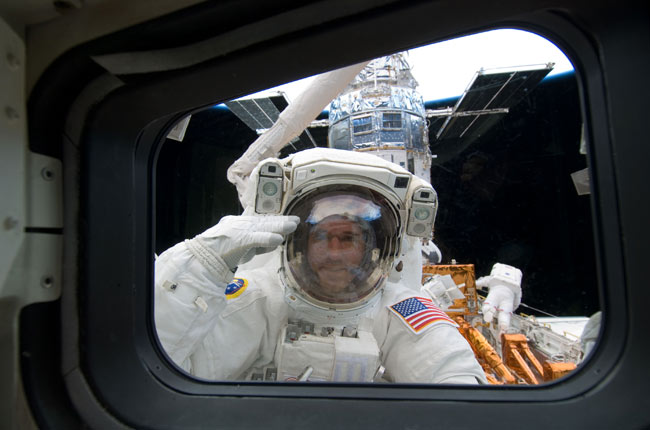Spacewalkers Tackle Daunting Hubble Telescope Repair

Thisstory was updated at 12:54 p.m. EDT.
HOUSTON ? Twospacewalking astronauts resorted to ?Plan C? Sunday to remove a stuck bolt onthe Hubble Space Telescope that blocked their efforts to begin the second dauntingrepair of their mission: resurrecting a long-broken instrument that can samplethe atmosphere of distant alien planets.
Atlantisastronauts Michael Massimino and Michael Good floated outside their shuttle at9:45 a.m. EDT (1345 GMT) to resuscitate Hubble?s jack-of-all-tradesspectrograph, which failed after a power failure in 2004.
NASAexpected the repair to be one the mission?s most challenging tasks, primarilybecause the instrument was never built to be fixed in space. Its powersupply sits behind a panel locked down by more than 117tiny screws.
But a stuckbolt on a handrail blocking access the panels stymied the astronauts. The handrailhad to be removed, but the bolt was stripped and two attempts failed to unscrewit. Mission Control finally told Massimino to rip the handrail from Hubble with brute force,shearing the bolt off. The move, Plan C, would take some serious strength,Mission Control said.
?I thinkyou?ve got that in you,? astronaut Andrew Feustel told the spacewalker frominside Atlantis.
?I can try,?Massimino said.
Get the Space.com Newsletter
Breaking space news, the latest updates on rocket launches, skywatching events and more!
It is thefourth of five crucial back-to-back spacewalks by Atlantis astronauts toupgrade and repairHubble to extend its mission life through at least 2014. Atlantis? 11-daymission is NASA?s fifth and final flight to the iconic observatory before theagency retires its three-orbiter fleet next year.
A vitaltool
The targetof Sunday?s spacewalk - the Space Telescope Imaging Spectrograph, or STIS- was installed on Hubble in 1997. It can pick beams of light apart intotheir component wavelengths to find the chemical make-up of objects likeplanets, comets and galaxies. But unlike other spectrographs, STIS can buildimages, too, and was built for versatility.
?It hasmany bells and whistles,? Hubble?s senior project scientist Dave Leckrone toldreporters here at NASA?s Johnson Space Center on Saturday.
In additionto being the first to discover the chemical composition of the atmospherearound an extrasolar planet, the spectrograph was also the first to detect thetell-tale signs of a supermassiveblack hole in the heart of galaxy, Leckrone said. So scientistsunderstandably want it repaired if it?s possible, he added.
Tinyscrews in space
Massiminoand Good plan to spend nearly five hours replacing the circuit board-like powersupply that sits behind a panel secured by 117 tiny screws, many of differentsizes and some which have washers. Each of those screws and washers need to beremoved (but not lost in space) in order to reach the power supply board. Ahandrail must be removed as well.
?Theproblem is that this thing was not supposed to be changed out in space,?Massimino has said. ?It?s hard enough to change the thing out on the ground.?
NASAengineers built a custom-made capture plate with color-coded holes for eachscrew size. The holes are large enough to fit over a screw and allow ascrewdriver bit in, but secure enough to lock loose screws inside so they don?tdrift away. The engineers also built a new array of tools so Massimino couldtackle the intricate, hand-intensive repair while wearing a bulky spacesuit andthick gloves.
Hubblescientists and mission managers had confidence in the repair based on theapparent ease of similarrepair work on the telescope?s Advanced Camera for Surveys, which adifferent pair of spacewalkers pulled off on Saturday.
Engineerson Earth declared that camera repair a partial fix - but still successful -late Saturday since it revived two of the camera?s three imaging channels,including a vital wide-field camera used by Hubble to build its trademark deepviews into the cosmos.
?I thinkit?s going to go extremely smoothly,? Leckrone said of today?s spacewalk,adding that the astronauts also plan to install much-needed thermal insulationon Hubble as well.
Massimino,in particular, has practiced removing the screws on Earth exhaustively until itbecame second nature, Leckrone said.
His besttime? A swift 40 minutes, mission managers said.
?That?sextraordinary,? Leckrone said.
SPACE.comis providing continuous coverage of NASA's last mission to the Hubble SpaceTelescope with senior editor Tariq Malik in Houston and reporter ClaraMoskowitz in New York. Clickhere for mission updates, live spacewalk coverage and SPACE.com'slive NASA TV video feed.
- New Video - Hubble's STIS: The Ultimate Repair Job, Repaired Camera
- Image Gallery - The Hubble Repair Missions: Part 1, Part 2
- New Video Show - Hubble's Final Shuttle Service Call
Join our Space Forums to keep talking space on the latest missions, night sky and more! And if you have a news tip, correction or comment, let us know at: community@space.com.

Tariq is the Editor-in-Chief of Space.com and joined the team in 2001, first as an intern and staff writer, and later as an editor. He covers human spaceflight, exploration and space science, as well as skywatching and entertainment. He became Space.com's Managing Editor in 2009 and Editor-in-Chief in 2019. Before joining Space.com, Tariq was a staff reporter for The Los Angeles Times covering education and city beats in La Habra, Fullerton and Huntington Beach. In October 2022, Tariq received the Harry Kolcum Award for excellence in space reporting from the National Space Club Florida Committee. He is also an Eagle Scout (yes, he has the Space Exploration merit badge) and went to Space Camp four times as a kid and a fifth time as an adult. He has journalism degrees from the University of Southern California and New York University. You can find Tariq at Space.com and as the co-host to the This Week In Space podcast with space historian Rod Pyle on the TWiT network. To see his latest project, you can follow Tariq on Twitter @tariqjmalik.









